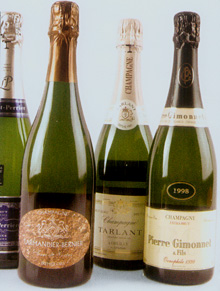 |
 |
 |
 Entertainment | Restaurants & Dining | October 2006 Entertainment | Restaurants & Dining | October 2006  
Acid Trip
 Jordan Mackay - 7x7SF Jordan Mackay - 7x7SF


| Dry Champagnes can't hide behind the sugar-which means when they're good, they're very, very good.

What to Drink:

Laurent-Perrier Ultra Brut ($30)
An almost even blend of Chardonnay and Pinot Noir grapes, this Champagne is aged for four years before release. Light-bodied and crisp with notes of lemon and orange zest, it has an unmatched length of finish. It's best consumed as an aperitif or with shellfish or caviar.

Larmandier-Bernier Terre de Vertus ($55)
From one of the greatest grower-producers in Champagne, the name of this wine translates as "the earth of Vertus" because, with no added sugar, the terroir is directly expressed. The wine has a mineral taste, with chalk and pear on the nose and a clean, swift finish.

Tarlant Brut Zero ($27)
Equal parts Pinot Meunier, Pinot Noir and Chardonnay-some of it stored in wood-give this wine a rounder texture and more richness than the Ultra Brut. But it's still got a clean, bracing zing. Try it with smoked salmon.

Pierre Gimonnet & Fils Cuvee Oenophile Extra Brut 1998 ($55)
This wine is made with all Chardonnay grapes. There's an apple perfume and oyster shells on the nose. Profoundly austere, it's more intellectual than hedonistic and is even better served with food, preferably oysters. |
If you want to appear cool in the wine world, try calling yourself an "acid freak" - a term that describes someone whose taste has evolved from only enjoying wines that are fruity and accessible to appreciating ones that are racy, structured and austere (just as art connoisseurs often begin liking impressionism and end up preferring abstract expressionism).

The latter qualities are found in wines that are high in acidity, a characteristic typical of Chablis, German or Austrian Riesling and Champagne. Most high-acid wines (usually whites) are balanced with sugar. They might not taste sweet, but they're not technically dry; the sugar helps keep your mouth from puckering up.

In bubbly lingo, the dosage (say it with a French accent) is the bit of sugar added to sparkling wine just before the cork is put in. Of all the acid-freak wines, the super freak is, without a doubt, non-dosage Champagne. But to get by without sugar, a wine has to be darn good.

"The only Champagnes that can work totally dry are those that have the kind of concentration of fruit that derives from very careful vineyard work," says Hiram Simon, a Berkeley-based distributor of many fine Champagnes for Wine Wise. "When it works, they can have a clarity of flavor that can be quite dramatic."

Several small grower-producers offer dry Champagnes - notably Larmandier-Bernier Terre de Vertus, Pierre Gimonnet et Fils Cuvee Oenophile and Tarlant Brut Zero. But among the larger houses, only Laurent-Perrier dares to market one, and its Ultra Brut is one of the best.

Because the grapes needed to make it are special (only in certain years do the vines produce grapes that have a soft, natural acidity when ripe), it's made in small quantities. It's so sharp you can almost feel its edges with your tongue. It rushes through the mouth with the intensity of the TGV, and while most Champagnes leave a tangy ring in your mouth for a few seconds, its finish goes on and on.
Sugar Dose: From Brut to Sec

Brut (pronounced "brute") - the French term for "crude" or "raw" - generally refers to Champagnes that taste dry. However, in technical terms, a Champagne labeled "brut" need only contain 15 or fewer grams of residual sugar per liter, so the wines have varying levels of sweetness. A wine labeled "extra brut" should have fewer than six grams of sugar per liter and will taste very, very dry. And while there is no designation for completely dry Champagnes, their names - ultra brut, maxi brut and so on - generally reflect their sugar content. Ironically, Champagnes labeled sec, which means "dry," are sweet, containing anywhere from 17 to 35 grams of sugar per liter. Demi-sec is rare, but it's the sweetest of them all. -JM | 
 | |
 |



